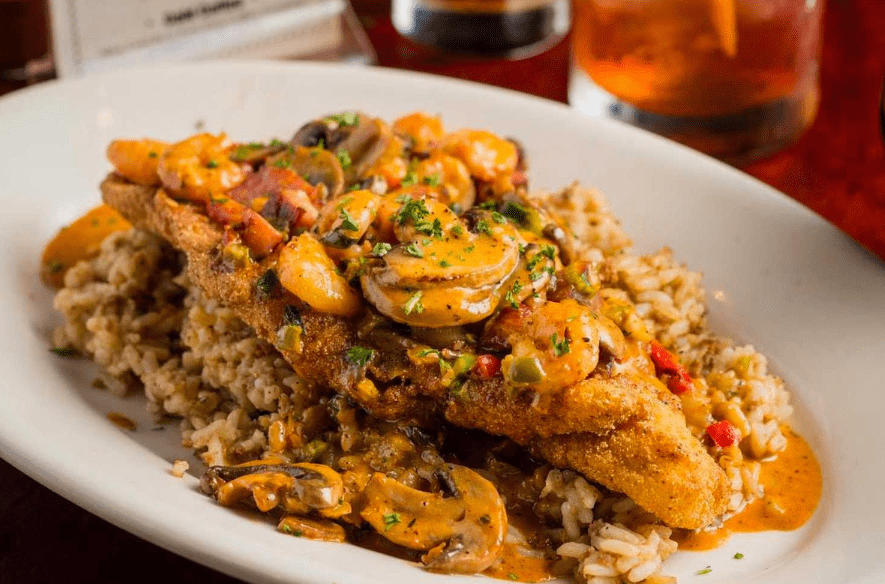
- Robert St. John says after 62 years of living on — and nearby — Gulf waters, “I probably don’t say enough prayers of gratitude for the culinary blessings I have likely come to take for granted.”
This month kicked off my 44th year in the restaurant business. The first seven years were spent working for other people. Mostly as a server while I worked my way through college. But for the past 37 years I’ve owned restaurants. I love my line of work and consider myself overly blessed to have a career in which I am making a living doing what comes naturally and easy to me. My livelihood is what I’d be doing on the side— and as a hobby— if I had another career. Ultimately, I truly love what I do.
In interviews with various publications and news outlets one of the questions questioners always ask is, “What is your favorite ingredient?” I don’t necessarily have a personal favorite ingredient— though I love steak and all varieties of seafood— but I would say the one protein that put our restaurants on the map, from day one on December 27, 1987, is seafood, more specifically, fresh Gulf fish.
When I opened the first restaurant there weren’t any restaurants in my hometown serving fresh Gulf fish. I’m not sure if there are more than a couple of restaurants here today serving non-frozen Gulf fish. I planted our flag on serving fresh Gulf fish from day one.
Before opening that first restaurant, the last job I had waiting tables was in Destin FL at Harbor Docks. It was a great experience, but also a learning one, as they owned a wholesale seafood company where boats pulled up to the dock behind the restaurant and unloaded fresh fish every morning. It was my dream to take that principle and bring it to Hattiesburg, Mississippi.
Realizing that dream was challenging in the early days. There were plenty of fresh, Gulf fish and seafood suppliers in New Orleans and on the Gulf Coast, but none were delivering to Hattiesburg. Back then we only had a couple of independent restaurants in town, and all of them were serving frozen fish, if at all.
In the first couple of years, I had my buddies at the Harbor Docks wholesale facility in Destin pack fresh fish on ice and send it up on the Greyhound bus straight off of their docks on the Destin Harbor. Several times a week I would go to the bus station Hattiesburg and bring six or seven ice chests packed with fresh fish to our restaurant. Within a matter of years, our volume had grown to the point that the New Orleans, Mississippi Gulf Coast, and Alabama seafood suppliers took notice of the small little upstart restaurant in Hattiesburg that was moving tons of fresh Gulf seafood. Eventually they started making the trip to our back door from New Orleans and Coastal Alabama.
Today we receive trucks bearing fresh Gulf seafood six days a week.
For the past three decades the ever-present buzzword in culinary circles has been about farm-to-table when it comes to dining. Thanks to Harbor Docks—in the early days— and now several seafood suppliers from Louisiana to Florida, we have been GULF-to-table since 1987. At Crescent City Grill we go through more than nine tons of fresh filleted Gulf finfish every year.
Crescent City Grill also sells approximately 20 tons of shrimp each year. I used to know the count on Gulf oysters, but old age has kicked in and my deadline is such that I don’t have time to perform an accurate count. It’s a lot.
I’ve eaten fish all over the world but prefer seafood from the Gulf over all others. So, for someone in the restaurant business— who owns a restaurant that specializes in fresh fish— I am blessed to live this close to the world’s greatest bounty.
Being one of the state’s largest purveyors of fresh fish is a long way from the kitchen environment of my youth. My mother was a devout Methodist, but her second religion was fish sticks. My brother and I ate a lot of fish sticks growing up— straight out of the freezer, onto a cookie sheet, and into the oven, along with oven-baked fries (not a fan), and ketchup. That was at least a twice-a-week meal in my childhood home.
If I ever ate a piece of fresh fish as a child, it was on trips to New Orleans when my mother would take my brother and me shopping for Christmas gifts at Maison Blanche and then to lunch at Galitoire’s. Though that would have only been an opportunity to order fresh fish. I’m not sure I ever did. I was a fried shrimp guy, and unabashedly on occasion still am.
Around the time I turned 10-years-old, my grandfather took me to Baricev’s, a Biloxi restaurant that served oysters on the half shell. I was resistant at first, but once I took my first bite, accompanied by a cocktail sauce that I had overly spiked with horseradish and extra lemon, I was hooked.
So, shrimp, and oysters were my go-to seafood choices as a child. It wasn’t until I was in my mid-twenties, and working in Destin, that my love for fresh Gulf fish developed. There was a group of Baton Rouge boys around my age down there who had worked at a fine-dining restaurant called Joey’s located in the heart of Louisiana’s capital city. The executive chef at Joey’s took a job as the executive chef at Beachside Café in Destin and brought those young men with him to be line cooks, prep cooks, and dishwashers. It was supposed to be summer employment, but many of them stayed to live the beach life.
The executive chef was a classically trained French chef who had worked at Windows on the World in New York. He blended classical French techniques and mother sauces with the fresh bounty from the Gulf, and Destin cuisine was born. From there those chefs eventually struck out on their own and opened their own restaurants or became executive chefs in other Panhandle establishments. Many are still open and operating today.
One of those chefs was the opening chef at the Purple Parrot, but we had to fire him on opening night and, what seemed like a disaster in the moment, became a blessing because it forced me to get back in the kitchen and learn how to cook professionally. My mentor to that point came from that Destin school of chefs, so that became my style, and it still is to this day.
In those early days I thrived working with seafood in our kitchen. We were the first to serve crawfish in a restaurant in Hattiesburg. We were purchasing crab claws and frying them back when they were still a byproduct. Now they are pound-for-pound more expensive than filet mignon.
I did a lot with crabmeat in those days, and most of the early dishes I created for our restaurants featured crabmeat in some form. So, I guess if I were forced to admit to a favorite ingredient, it would be the sweet meat that comes from the Gulf of Mexico Blue Crab in all its forms.
After 62 years of living on — and nearby — Gulf waters, I probably don’t say enough prayers of gratitude for the culinary blessings I have likely come to take for granted.

More than 40% of all of America’s rivers and tributaries— from Pennsylvania to Montana, and some in Canada— come together at one point and pass through New Orleans before dumping into the Gulf of Mexico. We don’t have the pristine cobalt blue waters of many saltwater communities, but what we do have is an abundance of redfish, speckled trout, shrimp, oysters, crab, and deepwater species such as red snapper grouper, and the like.
You can have the sugar-white sand and clear water. I’ll take Mississippi seafood every time.
Onward.
#####
This Week’s Recipe: Paneed Red Snapper
INGREDIENTS
8 red snapper filets, 6-8 ounces each
4 Tbl clarified butter, divided
1 cup seasoned flour
4 cups sliced button mushrooms
1 1/2 cups green onion, sliced
3 ounces white wine
1 Tbl garlic, minced
1 1/2 cups Creole cream sauce
1 pound crawfish tails, cooked and peeled
2 Tbl fresh parsley, chopped
Creole Cream Sauce
2 cups heavy cream
1 Tbl Creole seasoning
2 Tbl Worcestershire sauce
2 Tbl Louisiana Hot Sauce
1 Tsp paprika
Place all ingredients in a double boiler over medium high heat and reduce by one-third until thickened.
INSTRUCTIONS
Preheat oven to 350. Put seasoned flour into a large shallow pan. Lightly flour filets. Heat half of the butter in a large skillet over medium high heat and brown both sides of the fish. Do not overload the sauté pan.
After the fish is brown, place filets on a baking sheet and cook in the oven for 5–10 minutes, depending upon the thickness of the filet. Add the remaining butter to the sauté pan and place mushrooms in skillet and sauté until tender. Add garlic and green onions and cook 2–3 more minutes. Deglaze with white wine and let wine reduce by one-half. Add the Creole cream sauce and simmer for one-two minutes. Stir in the crawfish and cook for 2 more minutes.
Remove filets from the oven and place on serving dishes. Evenly divide topping over fish and serve. Garnish with fresh parsley.
Yield: 6–8 servings











